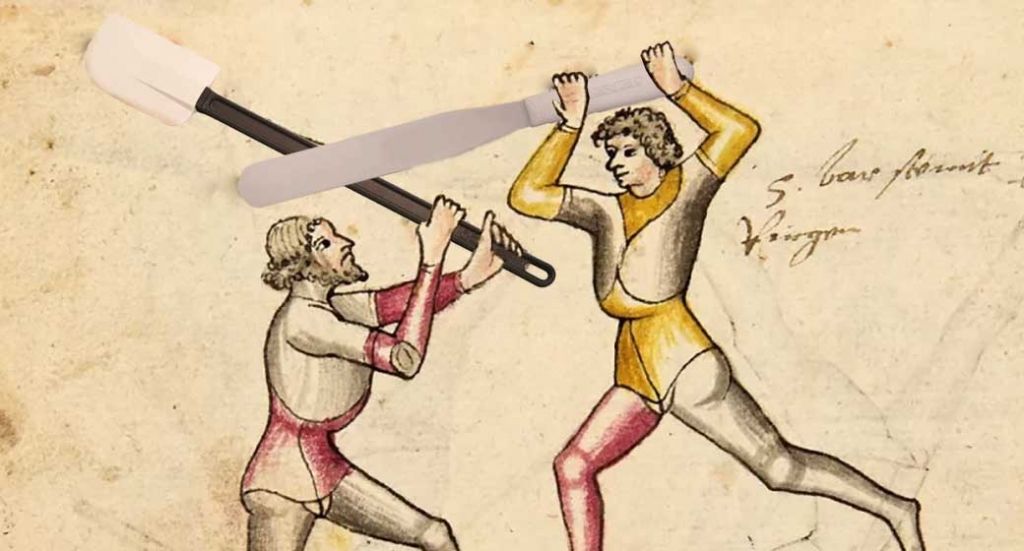
You may call it a spatula, a turner, a spreader, a flipper or any number of other names. Spatulas come in many different shapes and sizes. And there are just about as many uses for the humble spatula. But do you know the origin of the spatula? It might just surprise you!
The etymology of the word “spatula” goes way back to ancient Greek and Latin. Linguists agree that the basic root of the word comes from variations on the Greek word “spathe.” In its original context, spathe referred to a broad blade, like those found on a sword.
This was eventually imported into Latin as the word “spatha.” This was used to refer to a specific variety of long sword.
Getting Small
Before the modern word “spatula” came into being, it went through a number of transformations in both spelling and pronunciation. The origin of the word “spay” (like when Bob Barker would remind you to spay and neuter your pets on the “Price is Right“) referred to cutting with a sword. And when the diminutive suffix “-ula” was added, the result was a word meaning “little sword” – spatula!
So, in a way, a spatula is a kitchen sword!

>> Shop for Spatulas >>
But What is a Spatula?
In the modern world, the term spatula has come to represent any number of distinct kitchen tools. The most common uses of the term refer to kitchen tools used for flipping or turning, scraping, and spreading.
Turners
What many people think of when referring to a spatula is actually more precisely referred to as a turner in commercial foodservice. A turner has a broad, flat head attached to a handle.
As the name implies, a turner is used to turn or flip things. For example, you flip burgers on the grill with a turner that is often called a spatula.
Because these tools are so often used in cooking, they often come in high heat varieties. These rugged turners are meant to withstand contact with heated surfaces and even flames. Mercer Culinary’s appropriately named Hell’s Handle turners are designed with high heat in mind.

There are actually a number of different variety of turners as well. Some have longer handles while others are shorter. Some have slotted surfaces and others are solid. There are even turners designed for specific foods such as the Victorinox Slotted Fish Turner. It is designed with an angled edge and slotted surface to allow for easy turning on fish or other food items. The slots allow food juices to drain away. In Britain, this type of turner is known as a “fish slice.” But many folks would recognize this as a good, old-fashioned spatula.
>> Shop for Turners >>
Scrapers
For many cooks and bakers, a scraper is what they think of when referring to a spatula. Scrapers also come in many shapes and sizes, but often have common properties. For example, the typical scraper has a plastic or silicone blade. The blade often has a straight edge on one side and a curved edge on the other. As the name implies, it is designed to scrape food from the sides of bowls or pans.
Scrapers can also be used in cooking. Therefore, they can be designed to withstand high heat as well. You often see high heat scrapers used at omelet stations to cook the eggs.
And scrapers have morphed into other varieties as well. The most common variety combines the traditional scraper head with a concave, spoon-like shape. All these adjustments serve the primary goal of helping the chef scrape food or move it from one location to another.

>> Shop for Scrapers >>
Spreaders
To some kitchen purists, the only true spatula is a spreader. Spreaders are often used in baking for things like frosting cakes. Typically, the blades are straight and have a rounded tip. As you can see from the historical image above, modern spreaders have not strayed far from their roots.

A spreader is sometimes referred to as a “palette knife” as well. And spreaders also come in any number of variations in shape and size, based upon the particular need of the chef.
Beyond the Kitchen
Spatulas are also used in the scientific laboratory setting. They even have instruments called “microspatulas” that assist scientists in working with various chemical compounds. These spatulas tend to be made of all solid steel to resist the effects of the chemicals, powders or other substances used in the lab. They are also designed to withstand high heat as various solutions are heated or boiled as part of the scientific process.
Although these tools are slightly different than the humble kitchen spatula, they certainly share a common ancestor.
A Final Stab
In the end, the word “spatula” can refer to many things. But all of these variations can be traced back to a time when swords were common. And although a sword’s primary purpose may have been as a weapon, swords were also often used as tools as well. As things progressed, the elements of the sword evolved into what we would recognize as the modern spatula.
So when you are wielding your spatula in the kitchen, take a moment to reflect on its status as your premiere kitchen weapon!




Best Spatula Reviewed for 2020
What Are the Holes in A Spatula For? - HowdyKitchen